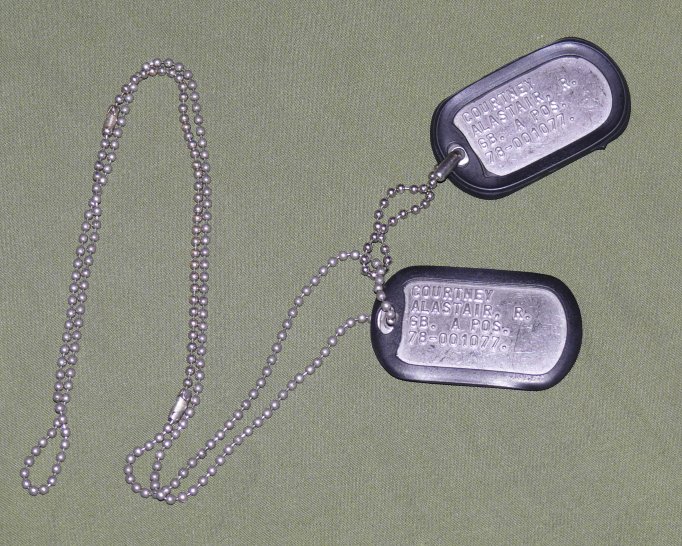Dog Tags: What Are They, & Why Do I Need Them?
First of all for those of you who are new to the military, and are wondering why you need to be tagged like a rabied pet, here's a brief explanation of Dog Tags.
The wearing of a personal identification tag, dates back to 6th century China, but did not become popular until the American Civil War, when paper notes pinned to the backs of uniforms, or individualised items of jewellery, provided essential details of the wearer were used by many on both sides. The slang description Dog Tags originated in Germany c.1870, when the first industrially produced identification discs were issued, as they looked the same as those used for tagging dogs. However it isn't really until the 20th century that most armed forces issued them as part of the field uniform. They have since become ubiquitous and have been seen in just about every war zone and war movie from Band of Brothers (WWII) through Full Metal Jacket (Vietnam), via The Hurt Locker (Iraq & Afghanistan) right through to Aliens (near future science fiction).
The best known design is that of the US militarys', which has been exported to numerous armed forces including the UNSGC. Comprising a pair of small, thin, rectangular stainless steel plates, that are suspended from two chains, one short (4"/100mm) and attached to the other, and one long (24"/610mm) worn around the neck. Each plate is embossed with the authorised text, with their edges protected by rubber "silencers", which not only make them more comfortable to wear, but quiet.
Dog tags are used for both identifying and treating casualties on the battlefield or with luck, in a hospital. The reason for two, is that in the worst case, the one on the short chain would be taken from the body as a record of death, the other being left with the corpse for future identification, assuming the body could not be immediately recovered for repatriation. With a live casualty the embossed data can significantly enhance survivability as it speeds treatment, carrying as it does, details of blood group and allergies.
Some forces are proposing to issue electronic tags, that have bio-metric data stored on an embedded chip, and the medics kitted out with a chip reader. However, like most armed forces the UNSGC has decided to continue with the traditional dog tag as it is less likely to malfunction.
Getting Yourself a Set of Dog Tags
Your first choice is material and colour. The standard military issue tags and chains come in a dull non-reflective silver-grey stainless steel finish, but the tags themselves are also available in aluminium or copper. Although you can get the sets in bright silver, black, gold or red, stick to the "dull silver" grey military issue types, as these others can be more difficult to read, and their finish wears off with time and makes them look tatty.
The rubber silencers come in a wide range of colours, the default is black, but any colour will do. If you really want your silencers in a different shade it is possible to get them in olive green, blue, red, yellow, orange, purple, "hot pink", clear and even ones in red, white and blue stripes
Next you can choose between the standard embossed capital letters, or a special order laser engraved type. Each tag can take up to five lines of text, each with 15 characters. For CONTACT operatives we use a set format as follows:
WAYLAND.
DEAN C.
GB. MALE.
A POS. NKA.
TFS00001.
|
|
|
-
LINE 1: Your family name, for example: "WAYLAND."
-
LINE 2: Your given name and middle initial if any, for example: "DEAN C."
-
LINE 3: Your nationality1 and gender, for example: "GB. MALE."
-
LINE 4: Your personal medical data: blood group2 and Allergy Recognition Code, for example: "A POS. NKA."4
-
LINE 5: Your UKARA4 Serial Number, for example: "TFS00001."
NB: the "full stops" make the text easier to read in the field.
[1] Use the ISO two letter country codes, which you can find
HERE.
For those with dual nationality, place a slash between the parts: "GB/NO."
[2] Your blood group is shown in the standard ABO format. However, some operatives will require to use the special "D UNO." blood group (please check if you are not sure).
[3] Allergy Recognition Codes: "NKA." for "no known allergies", or "NO PEN." for "no penicillin" as appropriate.
[4] United Kingdom Allocated Re-Asignable Number; your Off-world Operational Code serial number.
Where To Buy Your Dog Tags
Remember before ordering double check with your CO, to ensure that the data you plan to use is absolutely correct, and that there isn't a unit order being put together. Then try one of these on-line sources.
1800NAMETAPE.COM
Dog Tags Page
|
A US based company offering embossed stainless steel military specification Dog Tags. They offer silencers in standard black, "Glow in the dark yellow", "Urban Cammo", "ACU Cammo" (UCP) and "BDU Cammo".
|
1800NAMETAPE.COM
The US Army Page
|
The US Army page of the same company offering all the different varieties of name tapes, plates, helmet bands etc., that you may find of use.
|
|---|
|
ASMC
|
An on line German supplier of military kit, including dog tags, nametapes etc. Note you will have to click the "English" button and do a product search.
|

Dog-Tags.co.uk
|
A direct link to a UK company's page for ordering a set of US "style" embossed alluminum Dog Tags, with black silencers, a long 24" and short 5" chain.
|
|---|
|
Dog Tags On Line
|
A US based company specialising in just selling military specification stainless steel Dog Tags, but with either embossed, stamped or laser engraved text. They will do different text on each tag at no extra cost. Silencer colour choices include: black, blue, red, green, clear, neon orange and neon yellow.
|
|---|
|





